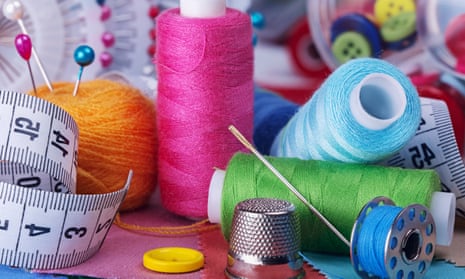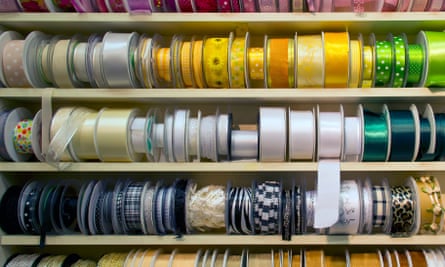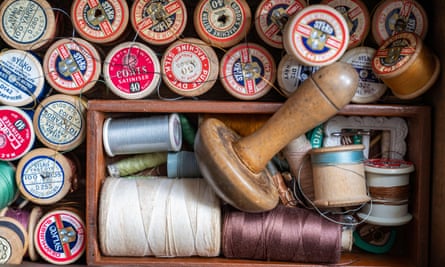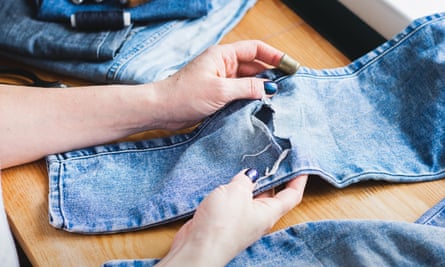Visits: 34
Trend to mend: cost of living crisis puts darning back in vogue
John Lewis says sewing shows and eco-awareness have pushed up haberdashery sales of thread, patches and even thimbles

Thrifty and eco-friendly consumers seeking to make do and mend rather than splash out on new threads are being credited with boosting sales of darning equipment and clothing repair products including patches, colour dye and thimbles.
The trend to mend means haberdashery – associated with the shopping experience as depicted in the1970s sitcom Are You Being Served? – is back in fashion, according to John Lewis.
The department store chain said it had sold out of darning needles and that sales of darning wool had doubled year-on-year, while sales of repair products such as patches and repair tape were up 61%.

Susan Kennedy, the head of haberdashery at John Lewis, said: “Whether they’re looking to rejuvenate their clothes, or have been inspired by the likes of Tom Daley’s knitting efforts last year, we’re seeing more and more customers turn to sewing, stitching and knitting.”
She said sales of dressmaking accessories, such as thimbles, dressmakers chalk and pattern-making accessories were up 15% year-on-year.
Many people are learning skills that their grandmothers took for granted, thanks to YouTube, Instagram and TikTok, with such pastimes given space to flourish during the pandemic lockdowns.
BBC One’s The Great British Sewing Bee has also fuelled the trend for stitching, while influencers such as Lily Fulop, Katrina Rodabaugh and Marlen Meiners promote fashionable ideas such as “visible mending” – making repairs look like beautiful artistic additions to a garment, such as embroidered flowers, rather than ugly fix-ups.
Patrick Grant, the host of The Great British Sewing Bee and founder of the Community Clothing label, said: “Mending in all its forms (simple sewing repairs, patching and darning) is most definitely on the rise. The web is filled with useful how-to videos on all aspects of making our clothes last longer.
“I think there are two things driving the rise. I suspect that the cost of living crisis has quite a bit to do with it. If we can save money by doing simple repairs then why wouldn’t we?

“But I think this trend has been growing for several years now and I think it’s largely been driven by our desire to consume less and throw less away for environmental reasons.”
Businesses and individuals have been prompted to take action amid evidence that the fashion industry is contributing more to the climate crisis than the aviation and shipping industries combined – 10% of global emissions. If trends continue, the industry could account for a quarter of the world’s carbon budget by 2050.
Grant said that “water pollution, soil erosion, and the mountain of plastic it leaves behind” only added to its impact.

Research by the waste charity Wrap has found that extending a garment’s life by just nine months can reduce its carbon, waste and water footprints by 20%-30%.
With that in mind, some retailers – including Zara and H&M – have begun offering repairs with an eye on the “circular economy” – which promotes the idea of reusing and recycling items.
Specialist services are also springing up to feed the trend – such as the Make Nu and Restory, which has an outlet at Harvey Nichols and works with the luxury online seller Farfetch.

Layla Sargent, the founder of The Seam – which connects skilled menders, cleaners and restorers with the public – said sales rose almost 300% year-on-year in 2022 with 70% of its sales from repairs, restoration and cleaning.
Sargent said her company was flourishing because people simply no longer have the skills to repair their clothes, particular in areas such as London with more transient populations that may be cut off from their family and local community.
Moth-hole repairs are one of The Seam’s most sought after services – with charges from £10 – and she was training additional technicians to keep up with demand.
“There is a changing mindset with a growing narrative about the circular economy, sustainability and responsible consumer behaviours,” she said. “Repair is a central element of the circular economy – you can’t keep renting out a dress unless you repair and wash it. You can’t sell items if they are not cared for and restored.”

